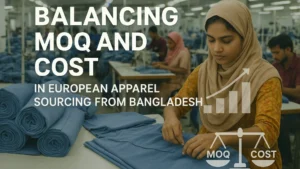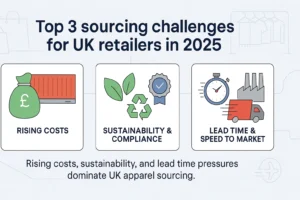
In today’s fashion industry, brands are no longer judged solely on their ability to produce trendy garments. Increasingly, consumers expect brands to demonstrate responsibility towards their employees, the environment, and society at large. This shift has led many fashion brands to adopt social objectives—defined actions aimed at achieving positive societal outcomes while remaining aligned with their business goals.
Social objectives are not just abstract concepts; they include measurable targets and plans of action that help fashion companies become socially responsible. They cover a wide range of areas, including environmental sustainability, fair labor practices, and contributions to social causes.
What Are Social Objectives in Fashion?
Social objectives are commitments that fashion companies make to improve their impact on people and the planet. These can range from reducing environmental footprints to improving the working conditions of employees. To fulfill these objectives, fashion brands typically outline specific goals that reflect their dedication to social responsibility.
For example, if a fashion company has the goal of reducing its environmental impact, it may adopt several social objectives, such as:
- Developing a sustainability plan.
- Sourcing eco-friendly materials.
- Partnering with suppliers who follow environmentally responsible practices.
- Reducing waste through circular fashion initiatives.
By clearly defining their social objectives, fashion brands can measure progress and make more informed decisions that align with both business goals and societal well-being.
The Intersection of Business and Social Objectives
Fashion brands that integrate their social and business objectives are often referred to as social enterprises. These businesses operate with the dual purpose of making a profit and solving social or environmental issues. According to the Social Enterprise Alliance (2018), a social enterprise addresses a fundamental unmet need or solves a social problem using a market-driven approach.
Here’s how various fashion brands structure their social and business objectives:
- Direct Alignment
In this model, a brand’s social objectives are fully integrated with its business model. For instance, Sseko Designs, a fashion brand operating in Uganda, provides employment and educational opportunities for women. This not only supports the local community but also aligns directly with the brand’s business goals by ensuring a steady workforce and promoting economic growth. - Overlapping Objectives
Some brands pursue objectives that are partially aligned. For example, TOMS Shoes operates on a “one-for-one” model, where for every pair of shoes purchased, a pair is donated to a child in need. While this supports their business model by encouraging customers to purchase shoes, it also addresses the social issue of children without footwear. - Separate but Complementary Objectives
In some cases, brands have social objectives that are separate from their core business but still contribute to the brand’s ethos. Conscious Step, for example, sells socks, but for every pair purchased, the company donates to a nonprofit partner, such as Action Against Hunger or Water.org. Although the donations are unrelated to the product itself, they reinforce the company’s commitment to social responsibility.
Why Social Objectives Matter in Fashion
Social objectives play a crucial role in shaping a brand’s reputation and success. They foster trust with consumers who increasingly prefer to buy from brands that share their values. For fashion brands, adopting social objectives helps create a more ethical and sustainable industry by addressing pressing global challenges such as:
- Climate change: Reducing carbon emissions and waste through sustainable production methods.
- Labor rights: Ensuring fair wages and safe working conditions in garment factories.
- Community development: Supporting educational and economic growth initiatives in local communities.
In today’s competitive market, having clear social objectives can help differentiate a brand from its competitors. Customers are more likely to support brands that take a stand on social issues, making these objectives essential for long-term success.
Fashion Brands as Social Enterprises: Leading Examples
- Sseko Designs: A socially conscious fashion brand that provides employment and education scholarships to women in Uganda. The company’s production facilities align directly with their mission to empower women while growing their business.
- TOMS Shoes: Known for its one-for-one model, TOMS gives away a pair of shoes for every pair purchased, demonstrating how business objectives can overlap with social goals.
- Conscious Step: By partnering with nonprofit organizations, Conscious Step donates to various causes for every pair of socks sold, showing how business and social objectives can complement each other.
The Future of Fashion: Integrating Social Responsibility
Fashion is evolving, and social objectives are playing a key role in this transformation. Brands that align their business goals with ethical practices are not only driving profitability but also creating lasting social and environmental impact. As consumers continue to demand more transparency and accountability, the importance of social objectives will only grow.
By prioritizing these objectives, fashion companies can not only contribute to societal well-being but also build stronger connections with customers who value ethical and sustainable practices.
For more information on fashion and social responsibility or in need of professional sourcing and production support? Reach out to me at antor@antor.xyz or visit my website https://antor.xyz for further inquiries and collaborations.
Share Button







20 Comments
Your blog is a true gem in the world of online content. I’m continually impressed by the depth of your research and the clarity of your writing. Thank you for sharing your wisdom with us.HABANERO88
Thank you so much, HABANERO88! Your kind words and support mean a lot to me. I’m thrilled to hear that you find the content valuable and well-researched. It’s readers like you who inspire me to keep sharing and improving. Thank you for being a part of this journey! 🌟
Mat6tube So nice! This was a truly wonderful post. Thank you for sharing this information
Thank you so much for your kind words, Mat6tube! I’m thrilled to hear that you enjoyed the post. It’s truly rewarding to know that the information resonated with you. Your support means a lot! 🌟
FlixHQ I enjoy posts that make readers think deeply. Thank you as well for giving me the chance to comment!
Thank you so much, FlixHQ! Your kind words and support mean a lot to me. I’m thrilled to hear that you find the content valuable and well-researched. It’s readers like you who inspire me to keep sharing and improving. Thank you for being a part of this journey!
I got this site from my buddy who shared with me on the topic of this site and now this time I am visiting this site and reading very informative posts here.
Thank you for sharing your experience! I’m glad to hear you find the posts informative. If you have any questions or need further insights, feel free to reach out to me at antor@antor.xyz. Looking forward to more engaging discussions!
Best regards,
Antor
Asking questions are genuinely pleasant thing if
you are not understanding something fully, however this
piece of writing provides pleasant understanding yet.
Thank you for your kind comment! I’m glad to hear that you found the piece of writing helpful and informative. If you have any further questions or need additional clarification, feel free to reach out to me at antor@antor.xyz. I’m always here to help!
Best regards,
Antor
Aw, this was an extremely nice post. Finding the time and actual
effort to make a good article… but what can I say… I procrastinate
a whole lot and never seem to get anything done.
Thank you for your kind words! I’m glad you enjoyed the post. Procrastination can be tough, but acknowledging it is the first step toward improvement. If you ever need tips or support to stay productive, feel free to reach out to me at antor@antor.xyz. Let’s make progress together!
Best regards,
Antor
Having read this I thought it was really enlightening. I appreciate you spending some time and effort to put this short
article together. I once again find myself personally spending way too much
time both reading and commenting. But so what, it was still worthwhile!
Thank you for your thoughtful comment! I’m glad you found the article enlightening. It’s always worth spending time on things that spark our interest and provide value. If you ever have any more thoughts or questions, feel free to reach out to me at antor@antor.xyz. Looking forward to more engaging discussions!
Best regards, Antor
My coder is trying to convince me to move to .net from PHP.
I have always disliked the idea because of the costs.
But he’s tryiong none the less. I’ve been using WordPress
on numerous websites for about a year and am concerned about switching to another platform.
I have heard great things about blogengine.net.
Is there a way I can import all my wordpress content
into it? Any kind of help would be greatly appreciated!
Thank you for your comment! I understand your concerns about switching platforms. BlogEngine.netdoes offer a way to import your WordPress content. You can use the BlogML format to migrate your posts, categories, tags, and comments. There are tools available to help with this process, such as the BlogML export utility for WordPress2. If you need any further assistance or have more questions, feel free to reach out to me at antor@antor.xyz. I’m here to help!
Best regards, Antor
I really like what you guys are usually up too. This type of clever work and coverage!
Keep up the amazing works guys I’ve included you guys to
my own blogroll.
Thank you for your kind words and support! We’re thrilled to hear that you appreciate our work and have included us in your blogroll. It’s feedback like yours that keeps us motivated to create more quality content. If you ever have any questions or need further insights, feel free to reach out to me at antor@antor.xyz. Looking forward to staying connected!
Best regards, Antor
My brother recommended I might like this website. He was
totally right. This post truly made my day. You can not imagine just how much time I had spent for this information! Thanks!
Thank you for your kind words and for sharing your experience! I’m thrilled to hear that the post made your day and provided the information you needed. If you have any more questions or need further insights, feel free to reach out to me at antor@antor.xyz. Happy to help!
Best regards, Antor